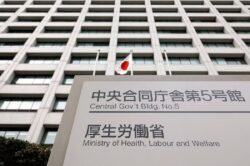
The common room of an accommodations facility for asymptomatic people set up by the Tokyo metropolitan government
14:48 JST, February 3, 2022
Rooms are available in accommodation facilities secured by prefectural governments in urban areas for people infected with the coronavirus, but it is proving tough to get booked into one.
The situation is partly the result of the rapid spread of the omicron variant and the subsequent backlog of coordination work, and because people who are at a higher risk of spreading infections are being prioritized for accommodations. However, in some instances, people have transmitted the virus to others while waiting for a room.
Spreading infections during processing
“If only I’d gotten a place earlier,” said a 32-year-old office worker from Itabashi Ward, Tokyo, who tested positive for the coronavirus on Jan. 24.
He lives in a two-story home with six people from four generations: a sick grandmother, his parents, his wife, 35, and son, 7.
To get accommodations, he had to apply via a public health center or by calling the Tokyo metropolitan government.
He called the metropolitan government the day he found out he was infected, but the official just said someone would contact him and to stay home.
The next day his son tested positive, and his wife’s positive result came on Jan. 27.
Someone from the health center contacted him on Jan. 27 to inquire about his health and said a few more days were necessary to secure a room.
Since testing positive, the man and his son have isolated in a room on the second floor of their home, but they have no choice but to share a toilet and bathroom with the other members of the family.
“There’s a limit to what’s possible while recovering at home,” he said. “If there are vacant rooms, they need to put people in them. If not, infections will spread.”
Prioritizing cases
As of Jan. 27, the metropolitan government had secured 5,420 rooms in 19 locations. However, only about 2,800 rooms were occupied.
“There is a backlog of communicating with people seeking rooms because of the rapid increase in cases,” said a metropolitan government official in charge when asked why nearly half of the rooms were vacant. “We’re also prioritizing certain people, such as those who can’t live separately from the people they live with, or students living in dormitories, so we need to keep some rooms open.”
On Jan. 25, the metropolitan government assigned extra staff to help take calls and perform other tasks, bringing the number of workers up from about 70 to about 140.
With Tokyo logging more than 10,000 new infections for several consecutive days, the metropolitan government plans to increase the number of rooms to 7,900 due to concerns about shortages.
However, some facilities have refused to provide rooms out of consideration for the feelings of local residents. In other cases, hotel guests have not consented.
The metropolitan government also plans to secure 1,000 rooms solely for asymptomatic cases.
“We need to keep ranking cases by priority, but we want to get as many people as possible in rooms,” the person in charge said.
Conditions in flux
In Osaka Prefecture as well, the spike in cases has created a backlog of work at public health centers, which are responsible for coordinating accommodations. Only about 20% of available rooms are reportedly being used.
During the period of Jan. 1-23, 451 of the calls to a line dedicated for people recovering at home were about getting accommodations, representing 5% of calls.
The callers were told to check into a hotel without waiting for the health centers to make a decision.
Also, the prefecture no longer requires people to be at least 40 years old, in principle, to get a room.
“We want to make full use of facilities to prevent even one more person from becoming seriously ill,” Osaka Gov. Hirofumi Yoshimura said at a press conference on Jan. 26.
Hyogo Prefecture had been allowing anyone who wanted to stay in accommodation facilities to get a room, but starting in mid-January, the prefecture began limiting hospitalization to patients with moderate symptoms who were at risk of becoming severe. The step was taken so patients could be monitored closely.
As a result, the utilization rate dropped to 30% from nearly 60%.
“I hope people will understand this was done so that we admit only people who really need care,” a prefectural official in charge said.
"Society" POPULAR ARTICLE
-

M4.9 Earthquake Hits Tokyo, Neighboring Prefectures
-

Israeli Tourists Refused Accommodation at Hotel in Japan’s Nagano Pref., Prompting Protest by Israeli Embassy and Probe by Prefecture
-

M7.5 Earthquake Hits Northern Japan; Tsunami Waves Observed in Hokkaido, Aomori and Iwate Prefectures
-

Tsukiji Market Urges Tourists to Avoid Visiting in Year-End
-

M5.7 Earthquake Hits Japan’s Kumamoto Pref., Measuring Upper 5 Intensity, No Tsunami Expected
JN ACCESS RANKING
-

Tokyo Economic Security Forum to Hold Inaugural Meeting Amid Tense Global Environment
-

Keidanren Chairman Yoshinobu Tsutsui Visits Kashiwazaki-Kariwa Nuclear Power Plant; Inspects New Emergency Safety System
-

Imports of Rare Earths from China Facing Delays, May Be Caused by Deterioration of Japan-China Relations
-

University of Tokyo Professor Discusses Japanese Economic Security in Interview Ahead of Forum
-

Japan Pulls out of Vietnam Nuclear Project, Complicating Hanoi’s Power Plans
























